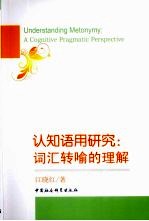图书介绍
认知语用研究 词汇转喻的理解PDF|Epub|txt|kindle电子书版本网盘下载

- 江晓红著 著
- 出版社: 北京:中国社会科学出版社
- ISBN:9787500477020
- 出版时间:2009
- 标注页数:201页
- 文件大小:7MB
- 文件页数:219页
- 主题词:认知科学:语用学-研究;词汇学-研究
PDF下载
下载说明
认知语用研究 词汇转喻的理解PDF格式电子书版下载
下载的文件为RAR压缩包。需要使用解压软件进行解压得到PDF格式图书。建议使用BT下载工具Free Download Manager进行下载,简称FDM(免费,没有广告,支持多平台)。本站资源全部打包为BT种子。所以需要使用专业的BT下载软件进行下载。如BitComet qBittorrent uTorrent等BT下载工具。迅雷目前由于本站不是热门资源。不推荐使用!后期资源热门了。安装了迅雷也可以迅雷进行下载!
(文件页数 要大于 标注页数,上中下等多册电子书除外)
注意:本站所有压缩包均有解压码: 点击下载压缩包解压工具
图书目录
Chapter One Introduction1
1.1 The importance of metonymy in verbal communication1
1.2 The target of research3
1.3 Rationale of the research8
1.4 Objectives of the study10
1.5 Methodology for the research13
1.6 Organization of the dissertation14
Chapter Two Review of the Relevant Literature15
2.1 Introduction15
2.2 Structuralist views16
2.3 The perspective of cognitive semantics18
2.3.1 Reference-point phenomena19
2.3.2 The idealized cognitive model22
2.3.3 Meaning elaboration25
2.4 The pragmatic approach28
2.4.1 Previous pragmatic accounts of metonymy28
2.4.2 A preliminary relevance-theoretic account of metonymy31
2.5 The limitations in current accounts of metonymy35
Chapter Three A Description of the Conceptual Framework37
3.1 Introduction37
3.2 The delimitation of metonymy for the present study37
3.2.1 Linguistic realization of metonymy37
3.2.2 The working definition of metonymy42
3.2.3 Distinguishing metonymy from metaphor45
3.3 Theoretical foundations48
3.3.1 Relevance theory49
3.3.2 Cognitive semantics57
3.3.3 The complementarity of cognitive semantics and relevance theory64
3.4 The characterization of the conceptual framework67
3.4.1 Constraints involved in metonymy recognition67
3.4.2 Comprehension heuristics employed in metonymy interpretation68
3.4.3 Cognitive effects achieved in metonymy interpretation69
Chapter Four Constraints on Metonymy Recognition71
4.1 Introduction71
4.2 Syntactic constraint:syntactic deviations72
4.3 Semantic constraint:violations of selection restriction77
4.4 Cognitive constraint:cognitive principles of relative salience80
4.4.1 Human experience81
4.4.2 Perceptual selectivity83
4.4.3 Cultural preferences84
4.5 Pragma-cognitive constraint:the constraining influence of context87
4.5.1 Dynamic context88
4.5.2 Mutual manifestness95
4.6 Conclusion99
Chapter Five Ad hoc Concept Construction of Metonymy101
5.1 Introduction101
5.2 Lexical pragmatics and ad hoc concept construction102
5.3 The "transfers of meaning"issue105
5.3.1 Reference transfer106
5.3.2 Contextual variability of word meaning108
5.4 An alternative solution to"transfers of meaning"111
5.4.1 Cracking contiguity relations of metonymy112
5.4.2 A refined relevance-guided comprehension heuristics121
5.4.3 A cognitive pragmatic interpretation of metonymy:an application126
5.5 Reference transfer and beyond135
5.6 Conclusion140
Chapter Six Cognitive Effects of Metonymy in Utterance Interpretation142
6.1 Introduction142
6.2 Economy considerations143
6.3 Contextual implications146
6.3.1 A trade-off between cognitive effort and cognitive effects147
6.3.2 Highlighting of associative relations150
6.4 Poetic effects153
6.4.1 Strong and weak implicature154
6.4.2 Speaking the unspeakable156
6.4.3 Achieving interpersonal effects162
6.5 Conclusion166
Chapter Seven Conclusion168
7.1 Major findings168
7.2 Implications174
7.2.1 Philosophical implications:sense and reference174
7.2.2 Linguistic implications:semantics-pragmatics distinction177
7.2.3 Logical implications:ways of inference and utterance interpretation180
7.3 Suggestions for further study182
Bibliography184
后记199
Lists of Figures and Tables20
Figure 2-1 Reference-point phenomena20
Figure 2-2 Metonymy expansion and reduction27
Figure 2-3 Descriptive and interpretive dimensions of language use32
Figure 3-1 Continuum view of metaphor and metonymy48
Figure 3-2 An integrated account of metonymy70
Figure 5-1 Narrowing103
Figure 5-2 Broadening104
Figure 5-3 Reference transfer108
Figure 5-4 A refined relevance-theoretic comprehension heuristics123
Figure 5-5 Types of metonymy135
Figure 5-6 The continuum of"strength of contact"136
Figure 5-7 Types of partonomy137
Table 2-1 A general procedure for the comprehension of metonymy34
Table 5-1 The comprehension heuristic steps involved in metonymy interpretation129